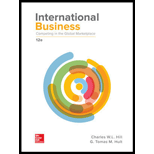
Case summary:
Company V decides to invest in Country R. The tariffs in Country R are more attractive for many manufacturers to make the investments. But in 2014 Country R faced some crisis. For now, Company V made a significant investment in Country R though the company faced some decline which results in overcapacity.
To qualify for the incentive program the company avoids the high import tariffs. Company V has to produce 300,000 vehicles in Country R by 2020 which cannot be obtained in the current market situation.
Characters in the case:
- Company V
- Country R
To discuss: The theory which explains the FDI of company V in Country R.
Introduction:
Foreign direct investment refers to the investment of a firm in one country and operating a business in another country.
Want to see the full answer?
Check out a sample textbook solution
Chapter IC Solutions
International Business: Competing in the Global Marketplace
- Please give me correct answer this general accounting questionarrow_forwardGeneral Accountingarrow_forwardQuestion: - How does resource attribution mapping enhance cost allocation? 1. Attribution wastes effort 2. Equal splitting works better 3. Usage patterns determine proper distribution methods 4. Simple rules suffice always help with thisarrow_forward
- What differentiates process-based validation from outcome testing? (A) Systematic review steps assess control effectiveness (B) Final results alone matter (C) Process review wastes time (D) Outcomes tell complete storyarrow_forwardProvide Right answerarrow_forwardLarkspur Manufacturing Company observed that, during its busiest month of 2022, maintenance costs totaled $18,500, resulting from the production of 40,000 units. During its slowest month, $13,000 in maintenance costs were incurred, resulting from the production of 25,000 units. Use the high-low method to estimate the maintenance cost that the company will incur if it produces 30,000 units. (Calculation in 2 decimal)arrow_forward
- Question: - How does resource attribution mapping enhance cost allocation? 1. Attribution wastes effort 2. Equal splitting works better 3. Usage patterns determine proper distribution methods 4. Simple rules suffice alwaysarrow_forwardAccurate answerarrow_forwardSubject: Financial Accountingarrow_forward
 Foundations of Business (MindTap Course List)MarketingISBN:9781337386920Author:William M. Pride, Robert J. Hughes, Jack R. KapoorPublisher:Cengage Learning
Foundations of Business (MindTap Course List)MarketingISBN:9781337386920Author:William M. Pride, Robert J. Hughes, Jack R. KapoorPublisher:Cengage Learning Foundations of Business - Standalone book (MindTa...MarketingISBN:9781285193946Author:William M. Pride, Robert J. Hughes, Jack R. KapoorPublisher:Cengage LearningMarketingMarketingISBN:9780357033791Author:Pride, William MPublisher:South Western Educational Publishing
Foundations of Business - Standalone book (MindTa...MarketingISBN:9781285193946Author:William M. Pride, Robert J. Hughes, Jack R. KapoorPublisher:Cengage LearningMarketingMarketingISBN:9780357033791Author:Pride, William MPublisher:South Western Educational Publishing Understanding Management (MindTap Course List)ManagementISBN:9781305502215Author:Richard L. Daft, Dorothy MarcicPublisher:Cengage Learning
Understanding Management (MindTap Course List)ManagementISBN:9781305502215Author:Richard L. Daft, Dorothy MarcicPublisher:Cengage Learning





